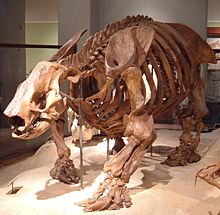- Mylodontidae
-
Mylodontidae
Temporal range: Oligocene - HoloceneParamylodon harlani. Texas Memorial Museum, UTA Scientific classification Kingdom: Animalia Phylum: Chordata Class: Mammalia Subclass: Theria Infraclass: Eutheria Superorder: Xenarthra Order: Pilosa Suborder: Folivora (partim) Family: †Mylodontidae
Gill, 1872Subfamilies - †Lestodontinae
- †Mylodontinae
and see text
Mylodontidae is a family of extinct mammals within the order of Pilosa and suborder Folivora living from approximately 23 mya—11,000 years ago, existing for approximately 22.89 million years.[1] This family of ground sloths is related to the other families of extinct ground sloths, being the Megatheriidae, the Nothrotheriidae, the Orophodontidae and the Scelidotheriidae. The only extant families of the suborder Folivora are the Bradypodidae and the Megalonychidae. Phylogenetic analyses using homologous sequences from all extant edentate groups indicates that the Mylodontidae were closer related to Megalonychidae than to Bradypodidae.[2]
The mylodontids together with their relatives the scelidotheriids and the orophodontids form the Mylodonta, the second radiation of ground sloths. The discovery of their fossils in caverns associated with human occupation lead some early researchers to theorize that the early humans built corrals when they could procure a young ground sloth, to raise the animal to butchering size.[3] However, radiocarbon dates do not support simultaneous occupation of the site by humans and sloths.[4] Subfossil remains like coproliths, fur and skin have been discovered in some quantities.
FAMILY †MYLODONTIDAE Gill, 1872
- Urumacotherium (incertae sedis)
- Subfamily Lestodontinae
- Tribe Thinobadistini
- Genus Thinobadistes
- Genus Sphenotherus
- Tribe Glossotheriini
- Genus Acremylodon
- Genus Ranculcus
- Genus Glossotherium
- Genus Paramylodon
- Genus Mylodonopsis
- Tribe Lestodontini
- Genus Lestodon
- Genus Lestodontidion
- Tribe Thinobadistini
- Subfamily Mylodontinae
- Genus Glossotheriopsis
- Genus Promylodon
- Genus Strabsodon
- Genus Megabradys
- Genus Pleurolestodon
- Genus Mylodon
Footnotes
- ^ http://paleodb.org/cgi-bin/bridge.pl?action=checkTaxonInfo&taxon_no=43629&is_real_user=1 Mylodontidae: Paleobiology Database
- ^ Hoss, Matthias; Dilling, Amrei; Currant, Andrew; Paabo, Svante (9 Jan 1996). "Molecular phylogeny of the extinct ground sloth Mylodon darwinii". Proceedings of the National Academy of Sciences 93 (1): 181–185. doi:10.1006/mpev.2000.0860. PMID 11161746. http://www.pnas.org/content/93/1/181.abstract. Retrieved 2009-12-28.
- ^ A.S. Woodward (1900)
- ^ Naish, Darren (28 Nov 2005). "Fossils explained 51: Sloths". Geology Today (Geologists' Association, Geological Society of London and Blackwell Publishing) 21 (6): 232–238. doi:10.1111/j.1365-2451.2005.00538.x. http://www3.interscience.wiley.com/journal/118652140/abstract. Retrieved 2009-01-29.
References
- Cuvier, G. (1796): Notice sur le squellette d'une très grande espèce de quadrupède inconnue jusqu'à présent, trouvé au Paraquay, et déposé au cabinet d'histoire naturelle de Madrid. Magasin encyopédique, ou Journal des Sciences, des Lettres et des Arts (1): 303-310; (2): 227-228.
- De Iuliis, G. & Cartelle, C. (1999): A new giant megatheriine ground sloth (Mammalia: Xenarthra: Megatheriidae) from the late Blancan to early Irvingtonian of Florida. Zool. J. Linn. Soc. 127(4): 495-515.
- Harrington, C.R. (1993): Yukon Beringia Interpretive Center - Jefferson's Ground Sloth. Retrieved 2008-JAN-24.
- Hogan, C.M. (2008): Cueva del Milodon, Megalithic Portal. Retrieved 2008-APR-13
- Kurtén, Björn and Anderson, Elaine (1980): Pleistocene Mammals of North America. Columbia University Press, New York. ISBN 0-231-03733-3
- McKenna, Malcolm C. & Bell, Susan K. (1997): Classification of Mammals Above the Species Level. Columbia University Press, New York. ISBN 0-231-11013-8
- Nowak, R.M. (1999): Walker's Mammals of the World (Vol. 2). Johns Hopkins University Press, London.
- White, J.L. (1993): Indicators of locomotor habits in Xenarthrans: Evidence for locomotor heterogeneity among fossil sloths. Journal of Vertebrate Paleontology, 13(2): 230-242.
- White, J.L. & MacPhee, R.D.E. (2001): The sloths of the West Indies: a systematic and phylogenetic review. In: Woods, C.A. & Sergile, F.E. (eds.): Biogeography of the West Indies: Patterns and Perspectives: 201-235.
- Woodward, A.S. (1900): On some remains of Grypotherium (Neomylodon) listai and associated mammals from a cavern near Consuelo Cove, Last Hope Inlet. Proceedings of the Zoological Society of London, 1900(5): 64-79.
External links
- Sloth World: An Online Sloth Bibliography.
- Picture and information about a ground sloth skeleton on display at the University of Georgia's Science Library.
- Academy of Natural Sciences ground sloth page.
- Illinois State Museum ground sloth page.
- Ground sloths at La Brea.
- Eremotherium in Florida.
- Have some ground sloths survived in Argentina?
- Ground sloths in general.
- Western Center for Archaeology and Paleontology Hemet, CA
Categories:- Prehistoric sloths
- Oligocene mammals
- Miocene mammals
- Pliocene mammals
- Pleistocene mammals
- Prehistoric mammals of South America
- Megafauna of South America
- Extinct cave organisms
Wikimedia Foundation. 2010.

